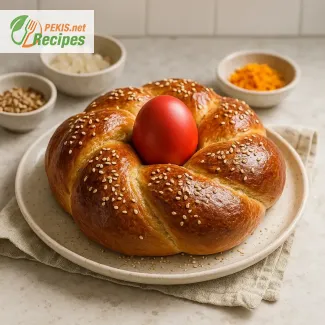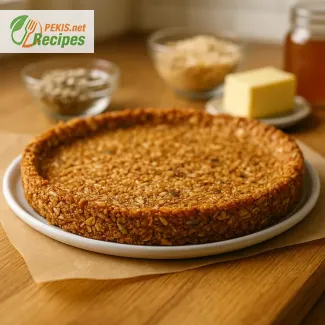
Discover the Rich Tradition of Greek Tsoureki – A Timeless Easter Delight
A symbol of celebration and rebirth baked into a golden, aromatic loaf
Among the many treasured Easter traditions in Greece, Tsoureki stands out not only as a culinary masterpiece but also as a cultural symbol of rebirth, hope, and togetherness. This braided sweet bread, known for its fragrant spices, golden crust, and airy texture, is much more than just a baked good—it's a heartwarming centerpiece of festive tables, passed down through generations and enjoyed with deep affection. Whether it’s your first time making it or you grew up savoring a slice every Easter Sunday, Tsoureki tells a story through its texture, aroma, and symbolism.
What sets Greek Tsoureki apart from other enriched breads is its signature blend of spices, most notably mahlepi (a spice made from wild cherry pits) and mastiha (an aromatic resin from the mastic tree of Chios). These unique flavors give Tsoureki its distinctly Mediterranean aroma, instantly evoking memories of Greek Orthodox Easter celebrations, bustling kitchens, and homes filled with the scent of sweet baking.
Tsoureki is traditionally braided with three strands, each representing the Holy Trinity, and is often adorned with a dyed red egg, symbolizing the blood of Christ and the promise of resurrection. This element of religious and cultural significance makes Tsoureki more than just bread—it becomes a living ritual, uniting family members around the table as they share in the sacredness of Easter.
The secrets behind the irresistible flavor of Tsoureki
From a baking perspective, Tsoureki is a rich, yeasted bread, made with eggs, butter, milk, and sugar, resulting in a texture that is soft, fluffy, and slightly chewy, similar to brioche or challah, yet uniquely Greek in its aroma and sweetness. The dough is kneaded until silky and elastic, then left to rise slowly, allowing the flavors to deepen and the texture to develop. This slow fermentation is key to creating the traditional airy crumb and glossy crust.
A defining feature of Tsoureki is the braid, which is not only beautiful but also meaningful. Braiding the dough before baking adds to the bread’s festive visual appeal while reinforcing its symbolic purpose. Often, a whole red egg is placed in the center of the braid before baking, making it a showstopping addition to any Easter table.
Traditional ingredients with a timeless story
The ingredients in Tsoureki are simple, yet every component plays a vital role in its flavor and texture. Mahlepi, with its subtle almond-cherry essence, and mastiha, which imparts a gentle pine-like sweetness, are irreplaceable. These ingredients are what give Tsoureki its signature taste that no other sweet bread can replicate.
Using high-quality flour, fresh eggs, and real butter is essential to achieving the light yet rich texture Tsoureki is known for. The dough is enriched but never heavy, balancing sweetness with the deep, slightly tangy notes of fermented yeast and warm spices. It’s the kind of bread that tastes like tradition but feels like comfort.
A festive centerpiece for all occasions
While Easter is the most traditional time to enjoy Tsoureki, its popularity has spread beyond springtime. Many Greek families now prepare this beloved bread for other celebrations, or simply when they crave its comforting texture and nostalgic flavor. It’s delicious when fresh out of the oven, spread with a touch of butter or jam, or enjoyed slightly toasted in the days that follow.
Some modern interpretations even turn Tsoureki into French toast, bread pudding, or sweet sandwich bases, though purists might argue it’s best enjoyed in its original, sacred form—still warm, torn by hand, and shared with those you love.
Embracing heritage through baking
Making Tsoureki from scratch is a deeply rewarding experience, not just for the delicious result, but for the act of connecting with Greek heritage and culinary history. Kneading the dough, forming the braids, waiting for the rise, and finally watching it turn golden in the oven becomes a meditative journey that celebrates the values of patience, love, and tradition.
Even if you’ve never been to Greece, baking Tsoureki allows you to experience a piece of its soul. The moment you open the oven and inhale the sweet, spiced aroma, you’ll understand why this bread holds such a special place in Greek hearts. And when you slice into the golden crust to reveal the soft, marbled crumb within, you’ll be tasting something truly timeless.
A loaf full of meaning, history, and flavor
In every slice of Tsoureki, there is a story—of family, faith, resilience, and the joy of celebration. It is a bread that speaks of gatherings under blooming spring skies, of candles flickering during midnight mass, of hands coming together to knead and braid, and of hearts filled with anticipation and love.
Whether you bake it once a year or make it a new tradition in your kitchen, Greek Tsoureki will quickly become one of those recipes you treasure. It’s the kind of bread that not only nourishes the body, but also feeds the soul—a sweet, braided ode to heritage and hospitality.
- Activate the yeast: In a small bowl, dissolve the fresh yeast (or dry yeast) in lukewarm water (30 ml / 2 tbsp) with 1 tsp of sugar. Let it sit for 10 minutes until it becomes foamy.
- Warm the milk: Gently heat the milk (120 ml / ½ cup) until just warm (not hot), and remove from the heat.
- Mix the base: In a large mixing bowl, combine warm milk, activated yeast, eggs (3), sugar (150 g / ¾ cup), orange zest (1 tbsp), mahlab (1 tsp), mastic (¼ tsp), and salt (3 g / ½ tsp). Stir gently to combine.
- Incorporate the flour: Gradually add flour (650 g / 5 ¼ cups), mixing with a wooden spoon or dough hook. Add butter (100 g / 7 tbsp), a few tablespoons at a time, and knead the dough for 10–15 minutes until it is soft, elastic, and slightly sticky.
- First rise: Cover the dough with a clean towel or plastic wrap. Let it rise in a warm, draft-free environment for 2–3 hours or until doubled in size.
- Shape the braids: Once risen, punch down the dough and divide it into 3 equal portions. Roll each piece into a long rope (about 40 cm / 16 inches), and braid them together. Tuck the ends under neatly.
- Second rise: Place the braided dough on a lined baking tray. If using, nestle a red-dyed egg in the center of the braid. Cover and let rise for another 1–1.5 hours until puffy.
- Egg wash and toppings: Preheat oven to 180°C (350°F). Beat egg yolk (1) with milk (15 ml / 1 tbsp) and brush over the surface of the braid. Sprinkle sesame seeds (10 g / 1 tbsp) if desired.
- Bake: Bake for 30–35 minutes, or until deep golden brown. If it browns too quickly, tent loosely with foil after 20 minutes.
- Cool: Let it cool completely on a wire rack before slicing and serving.
Elevating the Classic Tsoureki into a Signature Masterpiece
Expert techniques and creative twists to perfect your Easter bread every time
When it comes to traditional Greek baking, Tsoureki is a standout recipe cherished for its aromatic sweetness, rich symbolism, and soft, fluffy texture. However, even this time-honored favorite has room for personal expression and improvement. By tweaking ingredients, refining techniques, and understanding the science behind the bake, you can transform your Tsoureki from good to unforgettable. Whether you’re after a deeper flavor, a healthier alternative, or a more striking appearance, every choice matters in creating the ultimate version of this festive bread.
Enhancing flavor with ingredient upgrades
A great way to elevate Tsoureki is by choosing high-quality, fresh ingredients and experimenting with bold flavor additions that respect the bread’s traditional profile.
Swap white sugar for honey or orange blossom syrup
Using honey instead of sugar not only adds a subtle floral sweetness but also gives the bread a deeper, more complex taste. Orange blossom syrup, commonly used in Middle Eastern and Mediterranean baking, pairs beautifully with the existing orange zest in the recipe and enhances the bread’s citrus aroma.
Infuse the milk with aromatics
Before adding milk to the dough, you can infuse it with whole cloves, cinnamon sticks, or star anise. Strain before mixing to add depth without altering texture. This creates a background warmth that complements mahlepi and mastic, and adds a layered flavor profile.
Incorporate orange juice and zest
Replace some of the liquid with freshly squeezed orange juice, which boosts the natural citrus element. Combined with plentiful orange zest, it intensifies the bright, zesty notes that make Tsoureki so distinctive.
Add vanilla bean paste
A touch of vanilla bean paste or high-quality extract enhances the sweetness and rounds out the spiced notes, giving the bread a smoother, more balanced flavor.
Texture: how to achieve that perfect soft crumb
Achieving the ideal texture is key to making Tsoureki exceptional. A few technique-focused changes can dramatically improve the final structure and mouthfeel.
Use bread flour instead of all-purpose
Switching to bread flour increases the gluten strength, which helps achieve that stretchy, stringy crumb typical of the best Tsoureki loaves. The result is a chewier, more resilient texture.
Incorporate tangzhong method
Borrowed from Asian baking, the tangzhong technique involves cooking a small portion of flour with water into a paste before adding it to the dough. This results in a moist and ultra-soft bread that stays fresh longer.
Double fermentation for complexity
Let the dough rise overnight in the refrigerator for a slow, cold fermentation. This process enhances both flavor and structure, creating a richer taste with a more developed gluten network.
Why homemade Tsoureki is superior
Homemade Tsoureki allows you to control every step, ensuring better quality, freshness, and customization.
- Freshness: The bread is eaten within hours of baking, at its peak aroma and softness.
- Ingredient control: You can avoid preservatives and artificial flavors found in store-bought versions.
- Personalization: You’re free to adjust sweetness, spices, and size of the loaf to match your taste.
Baking Tsoureki at home also connects you to the tradition on a more intimate, personal level, enriching the celebration beyond just taste.
Common mistakes and how to avoid them
Even experienced bakers can struggle with Tsoureki. Here’s how to sidestep the most frequent pitfalls.
Mistake 1: Dough that’s too dry
Adding too much flour too early is a common error. Tsoureki dough should be soft and slightly sticky. Use a dough scraper or oiled hands to knead instead of continually dusting with flour.
Mistake 2: Under-kneading
Proper kneading is essential for developing gluten, which gives the bread its elastic and airy texture. Use the windowpane test: stretch a piece of dough—if it forms a thin, translucent membrane without tearing, it’s ready.
Mistake 3: Overproofing
While proofing is crucial, overproofed dough collapses easily and loses its airy structure. Keep an eye on the dough—it should double in size, not triple.
Mistake 4: Baking too early
Some bakers put the loaf in the oven before the second rise completes. The result? A dense, uneven crumb. Make sure the braided loaf looks puffy and relaxed before baking.
Healthier alternatives that still preserve tradition
If you want to make Tsoureki a bit healthier, there are smart substitutions that don’t sacrifice taste.
Whole wheat or spelt flour
Replace 25–30% of the white flour with whole wheat or spelt flour for more fiber, vitamins, and minerals. These grains also add a slight nutty flavor that complements the spices well.
Reduce sugar
You can reduce sugar by up to 25% without negatively affecting the structure. Compensate with fruit-based sweetness, like finely chopped dried apricots or figs, folded into the dough.
Plant-based fats and dairy
Use coconut oil or olive oil instead of butter for a dairy-free version. Swap out the milk with unsweetened almond, oat, or soy milk to keep the texture moist and fluffy.
Creative twists for visual and taste appeal
If you’re feeling adventurous, consider giving your Tsoureki a modern touch.
- Add a chocolate swirl: Before braiding, spread the dough ropes with a mixture of melted dark chocolate and cinnamon for a decadent twist.
- Shape variations: Instead of one large braid, form individual mini-loaves or twisted knots—perfect for gifting or brunch spreads.
- Stuffed center: Incorporate a nut filling with walnuts, cinnamon, and honey, or a pistachio marzipan layer for something truly unique.
Making Tsoureki part of your culinary identity
Improving this traditional bread isn't about breaking from the past—it's about honoring it through mindful craftsmanship. Whether you stay true to the original recipe or explore modern interpretations, the result should reflect your own connection to food and tradition. Every small choice, from ingredient to technique, becomes part of your signature.
In the end, a well-crafted Tsoureki is more than a holiday staple—it’s a chance to showcase your creativity, attention to detail, and love for cultural heritage.
Allergens present:
- Gluten (from wheat flour)
- Eggs
- Dairy (milk, butter)
- Sesame (optional topping)
Substitution tips to eliminate allergens and gluten:
- Gluten-free option: Replace all-purpose flour with a gluten-free flour blend designed for yeast breads, and add 1 tsp xanthan gum for structure.
- Egg-free option: Use egg replacers like aquafaba (3 tbsp per egg) or commercial egg substitute.
- Dairy-free option: Substitute butter with plant-based margarine and milk with almond or oat milk.
- Sesame-free option: Omit sesame seeds or use crushed nuts (if no nut allergy) or rolled oats.
- Vitamin A: 150 IU – supports vision and immune health
- Vitamin B1 (Thiamine): 0.25 mg – helps convert food into energy
- Vitamin B2 (Riboflavin): 0.15 mg – supports cell function
- Vitamin B12: 0.4 µg – essential for red blood cells and brain function
- Folate: 55 µg – important for DNA synthesis and pregnancy
- Calcium: 25 mg – helps maintain strong bones and teeth
- Iron: 1.2 mg – vital for blood oxygen transport
- Magnesium: 15 mg – supports muscle and nerve function
- Phosphorus: 75 mg – helps build bones and teeth
- Potassium: 80 mg – regulates fluid balance and muscle contractions
- Zinc: 0.7 mg – supports immune function and metabolism
- Mastic gum-derived antioxidants: approx. 3 mg – support anti-inflammatory processes
- Orange zest flavonoids: approx. 10 mg – may reduce oxidative stress
- Mahleb phenolics: approx. 5 mg – known for antimicrobial and cardiovascular benefits
These antioxidants help combat free radicals in the body, supporting overall cellular health and reducing the risk of chronic inflammation.





